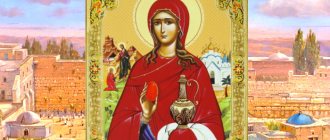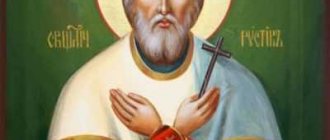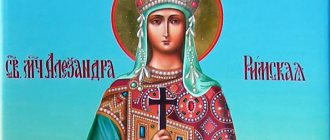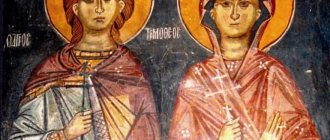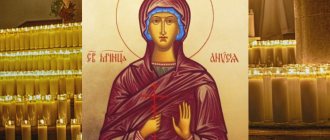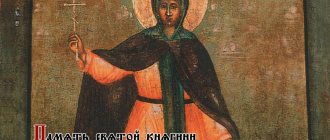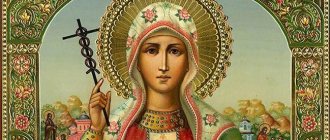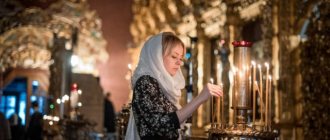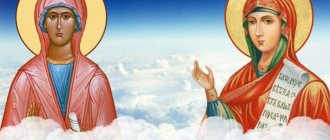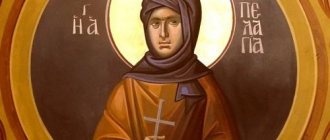| Blgv. Princess Anna of Novgorod. Icon of the 1970s, nun Juliania (Sokolova), Sergiev Posad. |
Anna of Novgorod, baptized Irina, in the world Ingigerda
(+ 1056), blessed princess, reverend, wife of the blessed Grand Duke Yaroslav the Wise and mother of the blessed Prince of Novgorod Vladimir Yaroslavich Memory on February 10 on the day of death, October 4 together with the memory of the blessed. Vladimir Yaroslavich [1], in the Cathedral of Novgorod Saints
The eldest daughter of the Swedish king Saint Olaf Shetkonung (994-1022), nicknamed the “Most Christian King”. In 1008, the king, his family and squad received holy baptism. She received an education that was exceptional for a woman of that time: she studied the Holy Scriptures, literature, and history. She was a true daughter of Scandinavia of the Viking Age and therefore from an early age she enjoyed great freedom, participated in the public life of her homeland, traveled, received guests, and was good with weapons. Historical sources especially note her intelligence, courage, and great influence on others.
In 1018, at the behest of her father, she married the one “who was worthy of his friendship” - Prince of Novgorod, blessed Yaroslav the Wise. As a dowry, she brought the city of Aldeigaborg (now the village of Staraya Ladoga) to the Russian land.
Having become the Grand Duchess of Kyiv in 1019, she gave all the strength of her soul and heart, all her blessed gifts to her new homeland, being a faithful assistant and adviser to her husband in his affairs. Once, when the hired Norwegian guard was indignant and asked the Grand Duchess to be a mediator between them and Yaroslav, she agreed, but warned that she would protect her husband’s interests. When his brother Mstislav Tmutarakansky came out against the Grand Duke with his army, Irina offered to resolve the dispute with a military duel with her, but Mstislav replied that he was not used to fighting women - and gave in to his brother.
The Grand Duke often had to go on long campaigns and trips, during which Irina remained in Kyiv, managing affairs.
Irina had a great influence on good relations with the northern countries of Europe. She sheltered in Kyiv the exiled sons of the English king Edmund Ironside, Edmund and Edward, as well as the Norwegian prince Magnus. He did not return to his homeland until the Grand Duchess was convinced that the Norwegians would give him the throne and his rights would be respected. The Russian state at that time played a significant role in the life of Europe, its authority and influence were higher than ever - and this was largely due to the Grand Duchess.
Already during her lifetime she became famous for her virtue and piety. Saint Hilarion of Kiev in his famous “Sermon on Law and Grace” writes, addressing the already deceased Saint Vladimir, the baptist of Russia: “Look at your daughter-in-law Irina, look at your grandchildren and great-grandchildren, how they live, how God protects them, how they keep the faith that you bequeathed to them, as they praise the Name of Christ!”
She became the mother of seven sons and three daughters. Her sons are especially famous: Holy Prince Vladimir of Novgorod, Grand Duke Izyaslav of Kiev, Svyatoslav of Chernigov, Vsevolod of Pereyaslavl.
Irina’s daughters, like their father, mother and brothers, were raised in a. The chronicler reports that Yaroslav “sown bookish words” in the hearts of people close to him. The Grand Duchess taught the children their native language, and they perfectly understood the Scandinavian sagas that the Varangian warriors sang at the prince’s court. The daughters of Irina and Yaroslav became queens: Anna - French, Maria - Hungarian, Elizabeth - Norwegian. It is known that the Grand Duchess founded a monastery in Kyiv in the name of her patroness, the Great Martyr Irina, and, according to the custom of that time, she had to not only take care of it, but also manage it.
In 1045, she went to Novgorod to visit her son Vladimir to lay the foundation stone for a cathedral in the name of St. Sophia the Wisdom of God. In Novgorod, Grand Duchess Irina took monastic vows with the name Anna. This was the first tonsure in the grand ducal house; with him began the tradition of tonsuring Russian princes and princesses after they had fulfilled their duty as rulers of the people. Here, in Novgorod, the holy princess Anna died on February 10, 1056 [2].
The Life of Noble Anna of Novgorod
Reverend Anna was the eldest daughter of the Swedish king Olof Shetkonung, whom his contemporaries also called “the most Christian king.” He ruled Sweden from 994 to 1022. Together with his wife, the monarch accepted the Christian faith and holy water baptism in 1008; his example was also followed by the entire royal squad and family members.
The eldest daughter Anna, who bore the name Ingigerda before her baptism, received a comprehensive education from early childhood, which was not typical for women of that era. In addition to the Holy Scriptures, she studied history, literature and other sciences that were previously considered necessary exclusively for men. Even then it was noticeable that the girl had a huge influence on those around her thanks to her intelligence and courage.
Since the girl was a descendant of the Vikings, this affected her character - from an early age she was distinguished by her love of freedom, she was not forbidden to take part in the public life of her country, and also to travel accompanied by a small retinue. She not only studied literacy and literary works, but also masterfully wielded weapons and sat perfectly in the saddle.
In 1017, King Olof decided to marry his eldest daughter to the Russian prince Yaroslav the Wise, calling him one who was truly worthy of his friendship. As a dowry for his daughter, the monarch gave the Swedish city of Aldeigaborg, which was later renamed Staraya Ladoga. The young princess converted to Orthodoxy before her wedding and received the name Irina.
In the person of the Swedish princess, Yaroslav the Wise received not only a caring wife, but also an intelligent adviser, who spent all her strength and resources on strengthening her new homeland. In those days, there were many hired soldiers in the service of the Russian prince, and one day the Norwegian soldiers began to express their discontent and rebel against Yaroslav, asking Irina to become a mediator in resolving this conflict. The princess agreed, but immediately said that she would completely and completely defend the interests of her husband.
Another story about Irina’s heroism has survived to this day. Yaroslav's brother, Mstislav of Tmutorakan, opposed the Grand Duke with a huge army, and then the princess invited him to fight with her. To which Mstislav replied that he does not fight women, and reluctantly, he gave in to his brother.
The great merit of the Grand Duchess is that during her reign Rus' acquired great authority among its European neighbors thanks to its wise and far-sighted policy. Irina sheltered the sons of the King of England, as well as the Norwegian Prince Magnus, and did not let him go until she was convinced that in his homeland he would be given all the honors due to his status and given the throne, which he was supposed to inherit after his father.
The reign of Kievan Rus by Yaroslav and Irina was a period of extraordinary rise of the state. It was then, on the initiative of the prince and princess, that the first collection of legislative provisions in Rus' was created. Yaroslav also introduced the obligation for clergy to teach children to read and write, and the first school began to function in Veliky Novgorod.
In addition to participating in the social and political life of the state, Irina devoted a lot of time to spiritual affairs. On her initiative, the monastery of the Holy Great Martyr Irene was founded in Kyiv, in whose activities she took an active part.
During her life with Yaroslav the Wise, the princess gave birth to ten children, whom she independently taught both Russian and Swedish. She paid special attention to the spiritual education of her sons and daughters, instilling in them the foundations of Christian morality from infancy.
The children of Yaroslav and Irina became famous people who did a lot for the further development and prosperity of Rus'. Of these, it is worth noting such personalities as Vladimir Novgorodsky, Svyatoslav Chernigovsky and Izyaslav Kyiv. The princess's daughters married European monarchs. So, Anna became the wife of the king of France, and Elizabeth was given as a wife to the Norwegian monarch.
Yaroslav and Irina sought to make Kievan Rus an organic part of European Christianity; under their rule, churches and monasteries were erected throughout the state, and a lot of time was devoted to the spiritual education of their subjects. Singers were invited especially from Greece to teach Russian church ministers how to sing Christian hymns.
Since the Grand Duke often had to leave the capital on business, the princess took over all management of Kiev; she enjoyed authority and love from both wealthy citizens and the poor. Already in those days, Irina became famous for her virtue and pious life, and even Metropolitan Hilarion cited her as an example to other princesses as a model of a Christian wife and housekeeper.
After the death of her beloved husband, Irina went to her son in Novgorod, where they planned to lay the foundation for a cathedral in the name of St. Sophia the Wisdom of God. There she announced her decision to take monastic vows, taking the name Anna. In the grand-ducal family, this was the first case after which Russian rulers developed a tradition of going to a monastery after they finished fulfilling their duties as rulers.
Until her death, Anna of Novgorod performed spiritual work and died in 1056. The Grand Duchess was buried in St. Sophia Cathedral. Her son, Prince Vladimir of Novgorod, was soon buried next to her.
Iconography
There are several types of icons that depict the pious Anna of Novgorod. On some, the Grand Duchess is depicted in full height and in robes befitting her princely position. On others, the saint is already depicted in monastic vestments, with a scroll in one hand. You can purchase the image of St. Anna of Novgorod in any church store or order it online.
Ingigerda, daughter of the Swedish king Olaf
Saint Anna of Novgorod (before the baptism of Ingigerd ) was the eldest daughter of the Swedish king Saint Olaf Shotkonung (994-1022), nicknamed “the most Christian king.” In 1008, the king, his family and squad received Holy Baptism. Ingigerda received an education that was exceptional for a woman of that time: she studied the Holy Scriptures, literature, and history. She was a true daughter of Scandinavia of the Viking Age and therefore from an early age she enjoyed great freedom, participated in the public life of her homeland, traveled, received guests, and was good with weapons. Historical sources especially note her intelligence, courage, and great influence on others.
Veneration of the Venerable Princess in Orthodoxy
The significance of the Grand Duchess, canonized by the Russian Orthodox Church, is that she was the first to combine two spiritualities - service to the state and monastic feat. The church did not prohibit re-marrying or leading an ordinary social life after the death of one of the spouses, but the wife of Yaroslav the Wise chose to devote the remaining days of her life to the Lord and his teaching. Following her example, many princesses began to take monastic vows after the death of their husbands, thus completing their marital service with dignity.
The Russian Orthodox Church has established a day of remembrance of the blessed princess Anna of Novgorod, it is celebrated on February 23.
Location of the relics
The relics of Anna of Novgorod were kept in the St. Sophia Cathedral, where the Grand Duchess was buried. With the advent of Soviet power, all valuables from the cathedral, including the relics of Blessed Anna, were transferred for storage to the city museum. In 1991, the Central Novgorod Museum returned the relics of the church, as well as the miraculous icon of the Mother of God “The Sign”. Today they are kept in the Church of St. Philip the Apostle in Veliky Novgorod.
Praise and Honor
The veneration of Saint Anna and her son Saint Vladimir was established after the sign that was given to the Novgorod Archbishop Saint Euthymius (✝1458, commemorated March 11 (24)) in 1439. In connection with this sign, the cathedral memory of the Novgorod saints buried in the Cathedral of Hagia Sophia was established.
Saint Equal-to-the-Apostles Olga and Venerable Anna of Novgorod, standing at the foundation of Russian female holiness, reveal two paths of service: spiritual and earthly motherhood. Both of these paths are under the favorable protection of the Most Holy Theotokos.
The first wife, Eve (life), is called in the Bible “the mother of all living” (Gen. 3:20), but she was named so after the Fall. The Holy Fathers say that such a glorious name is a prophecy about the second Eve - the Most Holy Virgin, who gives birth to Life Itself - the Creator and Savior of the world - and becomes the “Mother of all living.” The mystery of Her Motherhood contains the fullness of Divine love; in Her face the woman was exalted before the whole world - visible and invisible.
Christianity highly values a woman as a mother. Motherhood transforms human love, introduces a person to the mystery of the birth of life, created for eternity, for joy and beauty. A woman - a mother - is the keeper of the family and the family hearth. The inner peace and stability of the family depend on her gentleness, caring, patience, and ability to serve sacrificially. A woman has the highest task - raising new citizens of the Kingdom of Heaven. Grand Duchess Irina was such a mother.
The spiritual succession of Saints Olga and Anna is significant: Saint Olga, Equal-to-the-Apostles, builds the Church of St. Sophia in Kyiv - the main temple of Kievan Rus; Saint Anna of Novgorod participates in the foundation and construction of the Church of Hagia Sophia in Novgorod. The Venerable Anna became the guardian of the Church of St. Sophia in Novgorod, where her holy relics were open for veneration. Thus, Saint Olga and Venerable Anna affirm the spiritual vertical of Ancient Rus', connecting its two main spiritual centers: Kyiv and Novgorod.
The Venerable Anna of Novgorod laid the foundation for the union of two paths of holiness - the holy noble princesses (queens) and the venerable ones, i.e. active service to the world and prayerful contemplation, monastic feat.
Old Russian family life was based on strict piety, fulfilling the daily prayer rule, reading the Holy Scriptures, the Psalter, the Lives of Saints, and going to church. A family is first and foremost a home church. The spiritual ideal of Russian believers was the image of an ascetic monk. And many Russian people desired monasticism as the crowning achievement of their life’s journey.
The noble princesses of Rus', having become widows, did not marry a second time, although the Church did not prohibit second marriage. Monastic tonsure - betrothal to the Heavenly Bridegroom - became the path that most corresponded to the ideal life of a widow. Therefore, the tonsure of widows among princes and boyars became almost a rule. The Church decorated the completed feat of married life with the monastic rite. The nun princesses set an example for the Russian people of the worthy completion of monogamy.
The peculiarity of the path of the Monk Anna is revealed in her origin. The daughter of another people works to create Holy Rus', stands together with Saint Olga at the base of the ladder of Russian female holiness. The Venerable Anna embraces strangers as her own, without making distinctions, creating the unity of the human race. “Holy Queen Irene” was called her in the Northern countries - among the holy wives of these peoples, she was the first to shine and became the heavenly patroness and prayer book for them. Thus, the name Irina (peace), received by Ingigerda in Orthodoxy, turns out to be a deep expression of her Spiritual work.
In the image of the Venerable Anna of Novgorod we see the origins of many of the main directions of spiritual work of Russian women. The gracious help she provides is especially effective now. The creativity of the human personality was clearly manifested in the saint, and therefore she has the opportunity to help in choosing a path. Her whole life was a service to the Mother of God, who bestowed the saint with grace-filled gifts and happy motherhood. Therefore, the intercession of the Venerable Anna before the Most Pure One means so much.
Another name given to her during tonsure - Anna (grace) - indicates the only force that helps a person achieve holiness - the grace of God.
In 1991, the city museum returned to the Church the relics of the Venerable Anna of Novgorod together with another greatest shrine of Orthodoxy - the miraculous icon of the Mother of God “The Sign”.
In times of terrible dangers for their city, Novgorodians turned to the Mother of God, calling for Help, protection, an end to civil strife - and after common prayers, the Mother of the Lord protected her beloved city from harm. After many decades, we have the opportunity to pray before the Most Pure Image of the “Irresistible Wall”, “resisting the overthrowing militia.”
And with him the Heavenly Patroness of Veliky Novgorod returned to her children - the relics of the Venerable Anna of Novgorod openly reside in the Novgorod Church of the Holy Apostle Philip , bestowing grace-filled help and spiritual joy in our troubled times.
Texts of prayers
The prayer book contains canonical texts approved by the Russian Orthodox Church, which are recommended to be used when addressing the holy princess Anna of Novgorod. However, there will be nothing terrible if during prayer a person utters words that come from the heart.
It is better to pray in front of the image of the Grand Duchess, which is first consecrated in the temple. It is also recommended to purchase church candles or a lamp and light them during the ritual.
Troparion
Having risen from the west like a sky-bright star,/ you were deemed worthy to accept the Orthodox faith,/ bringing forth blessed fruit to the Russian land,/ the holy blessed princess Anno,/ Christ is at the heart of all with whom thou hast loved,/ Whom preserving justifications and laws;/ and today is thy all-holy memory Celebrating, // we accept the remission of sins through your prayers.
Translation: Having shone in the west like a heavenly star, you were worthy to accept the Orthodox faith, in which you brought blessed fruit to the Russian land, holy noble princess Anna, you loved Christ with all your heart, keeping His commandments and laws, therefore today celebrating your most holy memory, sins We receive forgiveness through your prayers.
Kontakion
Today in your bright memory/ Great Novgrad is rejoicing,/ calling all the faithful to brightly celebrate your memory,/ and we now, spiritually jubilant,/ joyfully glorify you and pray:/ holy I am faithful to Princess Anno,/ stand before the Holy Trinity/ pray to deliver Veliky Novgrad and the whole Russian land // from all troubles and circumstances and we will all be saved.
Translation: On the day of your blessed memory, Veliky Novgorod rejoices, convening all believers to brightly celebrate your memory, and now, spiritually triumphant, we joyfully glorify you and pray: “Holy Blessed Princess Anna, standing before the Holy Trinity, pray for the deliverance of Veliky Novgorod and the whole earth Russian from all troubles and adversities, and about the salvation of us all.”
What do they ask the saint for?
All believers turn to the image of the holy princess with prayers for the birth of children, for strengthening in faith, for strengthening the family, for protection from illnesses and troubles.
Text of the prayer:
O most glorious, reverend Grand Duchess Anno, you left your fatherland and settled in the Russian land, and you undertook great labors to establish the state. O reverend mother of God-wise Anno, namesake of grace, you shine in our land of miracles with grace, you are the prayer book for all Russian people. Hear us, praying to you, even though we are sinners, but with faith we flow to your honest relics - the treasure of Veliky Novgrad - and revive our perishing souls, enlighten our eyes of the heart, pluck them from the depths of sin and guide us on the path of repentance. Put the fire of Divine love into our hearts, make our minds wise, enlighten our feelings. Bring prayers to the Lord Jesus Christ and His Most Pure Mother, so that through your intercession they will preserve your city unharmed, which you loved, and all the cities of our country, may peace and truth, abundance and prosperity reign in them, and may we get rid of all the troubles found to the Russian land. Gather the scattered children of the Russian Orthodox Church with your love and prayer, and may all heresies and schisms be abolished in it. Preserve love between people, bring blessed peace and joy to homes, ask our land for beneficial air and an abundance of fruits. Do not disgrace our hope, firmly placed in you by God and the Most Holy Theotokos, but show us your intercession, so that we praise, glorify and magnify the Father, and the Son, and the Holy Spirit, forever and ever. Amen.
God bless you!
The best article for you, go to: Icon of Timothy of Olympia (in Symbols), the Hermit
You will also be interested in watching a video story about the blessed princess of Novgorod:
